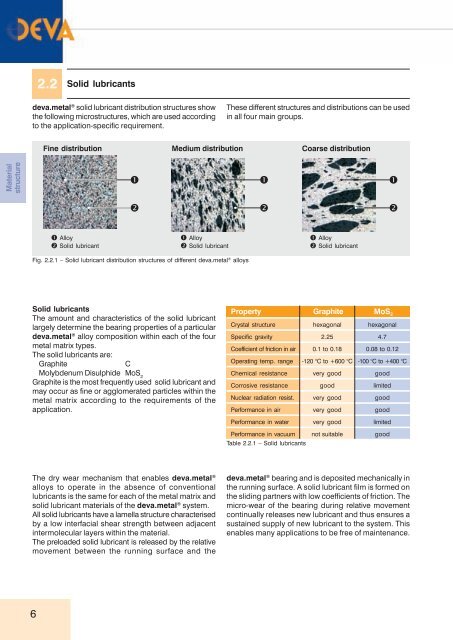deva.metal Handbuch EN für GGB - Supresores
deva.metal Handbuch EN für GGB - Supresores
deva.metal Handbuch EN für GGB - Supresores
You also want an ePaper? Increase the reach of your titles
YUMPU automatically turns print PDFs into web optimized ePapers that Google loves.
2.2<br />
Solid lubricants<br />
<strong>deva</strong>.<strong>metal</strong> ® solid lubricant distribution structures show<br />
the following microstructures, which are used according<br />
to the application-specific requirement.<br />
These different structures and distributions can be used<br />
in all four main groups.<br />
Fine distribution Medium distribution Coarse distribution<br />
Material<br />
structure<br />
<br />
<br />
<br />
<br />
<br />
<br />
Alloy<br />
Solid lubricant<br />
Alloy<br />
Solid lubricant<br />
Alloy<br />
Solid lubricant<br />
Fig. 2.2.1 – Solid lubricant distribution structures of different <strong>deva</strong>.<strong>metal</strong> ® alloys<br />
Solid lubricants<br />
The amount and characteristics of the solid lubricant<br />
largely determine the bearing properties of a particular<br />
<strong>deva</strong>.<strong>metal</strong> ® alloy composition within each of the four<br />
<strong>metal</strong> matrix types.<br />
The solid lubricants are:<br />
Graphite<br />
C<br />
Molybdenum Disulphide MoS 2<br />
Graphite is the most frequently used solid lubricant and<br />
may occur as fine or agglomerated particles within the<br />
<strong>metal</strong> matrix according to the requirements of the<br />
application.<br />
Property<br />
Crystal structure<br />
Specific gravity<br />
Coefficient of friction in air<br />
Operating temp. range<br />
Chemical resistance<br />
Corrosive resistance<br />
Nuclear radiation resist.<br />
Performance in air<br />
Graphite<br />
hexagonal<br />
2.25<br />
0.1 to 0.18<br />
-120 °C to +600 °C<br />
very good<br />
good<br />
very good<br />
very good<br />
MoS 2<br />
hexagonal<br />
4.7<br />
0.08 to 0.12<br />
-100 °C to +400 °C<br />
good<br />
limited<br />
good<br />
good<br />
Performance in water<br />
very good<br />
limited<br />
Performance in vacuum<br />
Table 2.2.1 – Solid lubricants<br />
not suitable<br />
good<br />
The dry wear mechanism that enables <strong>deva</strong>.<strong>metal</strong> ®<br />
alloys to operate in the absence of conventional<br />
lubricants is the same for each of the <strong>metal</strong> matrix and<br />
solid lubricant materials of the <strong>deva</strong>.<strong>metal</strong> ® system.<br />
All solid lubricants have a lamella structure characterised<br />
by a low interfacial shear strength between adjacent<br />
intermolecular layers within the material.<br />
The preloaded solid lubricant is released by the relative<br />
movement between the running surface and the<br />
<strong>deva</strong>.<strong>metal</strong> ® bearing and is deposited mechanically in<br />
the running surface. A solid lubricant film is formed on<br />
the sliding partners with low coefficients of friction. The<br />
micro-wear of the bearing during relative movement<br />
continually releases new lubricant and thus ensures a<br />
sustained supply of new lubricant to the system. This<br />
enables many applications to be free of maintenance.<br />
6




